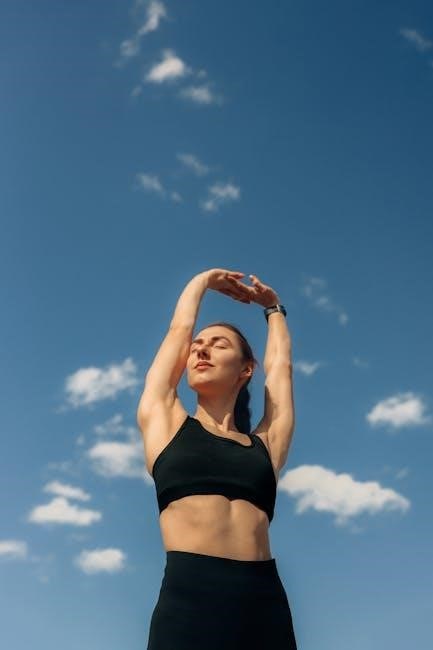The GLA:D program is a standardized‚ individualized approach for hip and knee osteoarthritis management‚ combining education and neuromuscular exercises to improve joint function and reduce pain.
1.1 Overview of the GLA:D Program for Hip and Knee Osteoarthritis
The GLA:D program is a standardized‚ individualized approach for managing hip and knee osteoarthritis. It combines guideline-based education and exercise therapy‚ focusing on neuromuscular training to improve joint function and reduce pain. The program consists of two educational sessions and 12 group exercise sessions over six weeks. Exercises target muscle control around the joints‚ with progression from basic to more challenging movements. The program emphasizes patient-specific tailoring‚ ensuring exercises align with individual needs and capabilities. By addressing both physical and educational aspects‚ GLA:D aims to empower patients to manage their condition effectively and enhance their quality of life.
1.2 Importance of Neuromuscular Exercises in Osteoarthritis Management
Neuromuscular exercises are crucial in osteoarthritis management as they target the muscles controlling joint movements‚ enhancing stability and reducing pain. These exercises improve muscle strength‚ coordination‚ and proprioception‚ which are often impaired in osteoarthritis patients. By addressing muscle dysfunction‚ they help restore normal joint mechanics‚ slowing disease progression. The GLA:D program emphasizes such exercises‚ focusing on controlled movements that minimize joint stress while maximizing muscle activation. This approach not only alleviates symptoms but also empowers patients to maintain functional independence‚ making it a cornerstone of effective osteoarthritis care. Regular practice of these exercises is essential for long-term joint health and mobility.
Structure of the GLA:D Program
The GLA:D program combines education and exercise‚ delivered over six weeks with two educational sessions and 12 group exercises‚ focusing on neuromuscular training and pain reduction.
The GLA:D program’s core components include two educational sessions and 12 group exercise sessions. The education focuses on osteoarthritis management‚ providing patients with insights into their condition‚ lifestyle modifications‚ and the importance of exercise in symptom relief. The exercise sessions are structured to enhance neuromuscular control‚ with a focus on improving joint stability and reducing pain. These sessions are delivered over six weeks‚ ensuring a comprehensive approach to managing hip and knee osteoarthritis effectively. The combination of education and exercise aims to empower patients with the knowledge and tools necessary for long-term joint health. The GLA:D program is structured over a six-week period‚ with two educational sessions and twelve group exercise sessions. Patients attend two exercise sessions per week‚ ensuring consistent progress and adherence. The program begins with education to establish a foundation for understanding osteoarthritis and the role of exercise. This is followed by a gradual introduction to the exercise regimen‚ tailored to individual needs. The standardized yet flexible design allows for adjustments while maintaining a focus on improving joint function and reducing symptoms. Regular participation is key to achieving the program’s goals and maximizing its benefits for hip and knee health. The GLA:D program includes two educational sessions‚ providing patients with guidelines for managing osteoarthritis and emphasizing the importance of exercise in improving joint health and function. The GLA:D program emphasizes standardized education to help patients manage osteoarthritis effectively. Sessions cover guidelines for reducing pain and improving joint function through tailored exercises and lifestyle adjustments. Physiotherapists deliver evidence-based content‚ focusing on the importance of neuromuscular training and its benefits for joint stability. Patients learn self-management strategies‚ such as proper movement techniques and progressive exercise principles. The program also provides resources like exercise diaries to monitor progress and pain levels‚ ensuring a comprehensive approach to osteoarthritis care. This educational foundation equips patients with the knowledge and tools needed to actively participate in their rehabilitation journey; Physiotherapists play a central role in the GLA:D program by delivering evidence-based educational content to patients with hip and knee osteoarthritis. They provide individualized guidance‚ ensuring patients understand the program’s principles and exercises. Physiotherapists also distribute resources like exercise diaries to monitor progress and pain levels. Their expertise ensures patients adhere to guidelines‚ promoting effective self-management. By addressing patient questions and adapting content to individual needs‚ physiotherapists are key to the program’s success‚ fostering a supportive environment for long-term osteoarthritis care. Their involvement ensures patients gain the knowledge and skills necessary for sustained improvement. The GLA:D program includes group sessions with structured exercises targeting hip and knee osteoarthritis‚ focusing on neuromuscular control and strength to enhance joint function and reduce pain. The GLA:D program offers structured group exercise sessions‚ typically conducted twice weekly over six weeks. These sessions focus on improving joint mobility‚ strength‚ and functional ability in individuals with hip and knee osteoarthritis. Each class is led by a certified physiotherapist‚ ensuring personalized attention and proper technique. The exercises are designed to enhance neuromuscular control‚ reducing pain and improving overall quality of life. Participants engage in a series of evidence-based exercises tailored to their needs‚ promoting long-term joint health and independence. The group setting also fosters motivation and camaraderie among participants. The GLA:D program follows structured exercise principles to ensure effectiveness and safety. Each exercise consists of 2-3 sets of 10-15 repetitions‚ with rest periods between sets. This framework helps build muscle strength and joint stability while minimizing fatigue. Rest periods are typically equal to the duration of one set‚ allowing optimal recovery. These principles are designed to progressively challenge participants‚ improving functional ability and reducing osteoarthritis symptoms. The structured approach ensures consistency and adaptability‚ catering to individual needs while promoting long-term joint health. This method is evidence-based and tailored to enhance neuromuscular control and overall mobility. The GLA:D program includes two progression levels: Level 1 (pelvic-lift with flexed knees) and Level 2 (pelvic-lift with semi-flexed knees)‚ tailored to improve joint function gradually. The GLA:D program’s Level 1 exercises begin with a pelvic-lift performed with flexed knees‚ focusing on strengthening the muscles around the hips and knees. This exercise is designed to improve pelvic stability and promote proper movement patterns‚ which are essential for managing osteoarthritis. Patients start by lying on their back with knees bent and feet flat on the floor. They then lift their pelvis while maintaining a neutral spine‚ ensuring minimal strain on the joints. This foundational exercise helps enhance muscle activation and joint alignment‚ preparing individuals for more advanced movements in Level 2. The short lever arm and bilateral loading in Level 1 make it accessible for those with limited mobility or pain. Level 2 of the GLA:D program introduces a pelvic-lift with semi-flexed knees‚ building on the foundational strength gained in Level 1. This exercise involves a long lever arm‚ increasing the challenge by engaging the hip extensors and glutes more intensely. Participants start in a supine position‚ knees slightly bent‚ and lift their pelvis while maintaining control throughout the movement. The semi-flexed knee position enhances joint mobility and strengthens the surrounding muscles‚ preparing individuals for daily activities requiring greater range and strength. This progression aims to improve functional capacity and reduce osteoarthritis symptoms effectively. The GLA:D program enhances joint function‚ reduces pain‚ and improves muscle strength‚ offering long-term benefits for individuals with hip and knee osteoarthritis through structured exercises and education. The GLA:D program significantly enhances joint function and muscle strength‚ particularly in the lower limbs. By focusing on neuromuscular exercises‚ participants experience improved stability and movement control‚ which are essential for daily activities. Strengthening the muscles around the hip and knee joints helps reduce the strain on these areas‚ leading to better overall mobility. These improvements are achieved through a structured progression of exercises that target specific muscle groups‚ ensuring sustainable benefits for individuals managing osteoarthritis. The GLA:D program effectively reduces pain and manages symptoms associated with hip and knee osteoarthritis. Through targeted neuromuscular exercises‚ participants often experience a noticeable decrease in joint discomfort. The structured approach helps improve joint stability and reduces inflammation‚ which are key contributors to pain. By addressing muscle imbalances and enhancing movement patterns‚ the program provides long-term symptom relief. Patients also benefit from educational sessions that promote self-management strategies‚ further aiding in pain reduction and overall well-being. This comprehensive approach ensures sustained improvements in both pain levels and quality of life for individuals with osteoarthritis. Physiotherapists must undergo certification to deliver the GLA:D program‚ ensuring they provide evidence-based education and exercises. Certification includes access to detailed educational materials and program guidelines. Physiotherapists must complete specific training to certify in the GLA:D program‚ ensuring proficiency in delivering guideline-based education and exercises. Certification requires adherence to program guidelines‚ completion of educational modules‚ and practical training. Access to detailed manuals and resources is provided to support therapists in implementing the program effectively. Regular updates and ongoing education are also recommended to maintain certification and stay current with evidence-based practices. This ensures high-quality care for patients with hip and knee osteoarthritis‚ aligning with the program’s standardized yet individualized approach. Certified GLA:D physiotherapists gain access to comprehensive educational materials‚ including detailed exercise manuals and patient resources. These materials are provided in PDF format‚ ensuring easy accessibility and distribution. The program includes an exercise diary for patients to track progress and a pain registration tool to monitor symptoms during exercises. Additionally‚ the materials outline the structured approach of the program‚ covering both educational and exercise components. This ensures physiotherapists can deliver the program effectively‚ adhering to its evidence-based guidelines and individualized approach for patients with hip and knee osteoarthritis. The GLA:D program is individualized‚ allowing exercises to be tailored to meet specific patient needs and goals‚ ensuring personalized care for hip and knee osteoarthritis management. The GLA:D program emphasizes tailoring exercises to individual patient needs‚ ensuring a personalized approach to hip and knee osteoarthritis management. Physiotherapists assess each patient’s abilities and goals to create customized plans. Exercises progress from Level 1 to Level 2‚ adjusting difficulty based on patient improvement. This individualization allows for better adherence and effectiveness‚ addressing specific pain points and functional limitations. The program’s flexibility ensures that each participant receives targeted therapy‚ maximizing their potential for improved joint function and reduced symptoms. Regular monitoring and adjustments further refine the exercise plan‚ ensuring it remains appropriate and beneficial for the patient. Monitoring progress is crucial in the GLA:D program to ensure exercises are effective and safe. Physiotherapists track patients’ improvements in joint function‚ strength‚ and pain levels. Adjustments are made based on individual responses‚ with exercises modified to suit changing abilities. The program encourages patients to use tools like exercise diaries to log progress and pain during workouts. Regular feedback sessions allow physiotherapists to refine the exercise plan‚ ensuring it remains challenging yet achievable. This iterative process helps maximize benefits and keeps patients motivated throughout the program‚ fostering long-term management of osteoarthritis symptoms. The GLA:D program provides patients with essential resources‚ including exercise diaries for tracking progress and pain registration tools. PDF materials are also available‚ offering detailed exercise guides and educational content to support home practice and better understanding of osteoarthritis management. The GLA:D program provides patients with an exercise diary to track their progress and document pain levels during exercises. This tool helps monitor symptoms‚ ensuring exercises are tailored to individual needs. By recording details such as exercises performed‚ sets‚ repetitions‚ and pain intensity‚ patients can identify patterns and share insights with their physiotherapist. This structured approach supports consistent practice and informs adjustments to the program‚ promoting safer and more effective osteoarthritis management. Regular use of the diary fosters accountability and collaboration between patients and healthcare providers. The GLA:D program offers comprehensive PDF materials available for free download‚ providing detailed exercise routines‚ educational content‚ and program structure. These resources include manuals like the GLAD MANUAL_2020‚ which outlines exercises for hip and knee osteoarthritis. Patients and physiotherapists can access these materials online‚ ensuring easy reference and implementation. The PDFs cover exercise principles‚ progression levels‚ and educational guidelines‚ supporting both home and clinical practice. This accessibility enables consistent and informed use of the program‚ fostering better outcomes for individuals with osteoarthritis. The GLA:D program effectively combines education and exercise to manage hip and knee osteoarthritis‚ offering a structured approach to improve joint function and reduce pain. The GLA:D program has proven effective in managing hip and knee osteoarthritis through a combination of education and neuromuscular exercises. By focusing on muscle control and joint stability‚ participants experience improved joint function and reduced pain. The program’s structured approach‚ including six weeks of twice-weekly sessions‚ ensures consistency and progression. Exercises like pelvic lifts and strengthening routines enhance muscle strength and mobility. Overall‚ the GLA:D program offers a comprehensive‚ evidence-based solution for individuals with osteoarthritis‚ promoting long-term symptom management and improved quality of life. Its standardized yet individualized design makes it accessible and adaptable to diverse patient needs. The GLA:D program has demonstrated significant benefits for individuals with hip and knee osteoarthritis‚ offering a structured approach to managing symptoms and improving quality of life. By participating‚ individuals can gain better control over their condition through education and targeted exercises. Physiotherapists play a crucial role in guiding patients‚ ensuring a safe and effective experience. For those interested in further learning‚ resources such as exercise diaries and downloadable PDF materials are available‚ providing additional support and insights. Embracing the GLA:D program can empower individuals to take an active role in their osteoarthritis management and enjoy lasting improvements in mobility and comfort.2.1 Core Components: Education and Exercise Sessions
2.2 Duration and Frequency of the Program

Educational Sessions
3.1 Guidelines for Patient Education
3.2 Role of Physiotherapists in Delivering Educational Content
Exercise Program Details
4.1 Group Exercise Sessions: Structure and Goals
4.2 Exercise Principles: Sets‚ Repetitions‚ and Rest Periods

Exercise Progression and Levels
5.1 Level 1 Exercises: Pelvic-Lift with Flexed Knees
5.2 Level 2 Exercises: Pelvic-Lift with Semi-Flexed Knees
Benefits of the GLA:D Program
6.1 Improvements in Joint Function and Muscle Strength
6.2 Reduction in Pain and Symptom Management

Certifications and Training for Physiotherapists
7.1 Requirements for GLA:D Program Certification
7.2 Access to Educational Materials and Resources
Individualization of the Program
8.1 Tailoring Exercises to Patient Needs
8.2 Monitoring Progress and Adjustments

Resources for Patients
9.1 Exercise Diary and Pain Registration
9.2 Availability of GLA:D Program PDF Materials
10.1 Summary of the GLA:D Program’s Effectiveness
10.2 Encouragement for Participation and Further Learning

